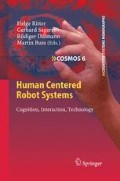Abstract
In this study we introduce a method for 3D trajectory based recognition of and discrimination between different working actions. The 3D pose of the human hand-forearm limb is tracked over time with a two-hypothesis tracking framework based on the Shape Flow algorithm. A sequence of working actions is recognised with a particle filter based non-stationary Hidden Markov Model framework, relying on the spatial context and a classification of the observed 3D trajectories using the Levenshtein Distance on Trajectories as a measure for the similarity between the observed trajectories and a set of reference trajectories. An experimental evaluation is performed on 20 real-world test sequences acquired from different viewpoints in an industrial working environment. The action-specific recognition rates of our system correspond to more than 90%. The actions are recognised with a delay of typically some tenths of a second. Our system is able to detect disturbances, i.e. interruptions of the sequence of working actions, by entering a safety mode, and it returns to the regular mode as soon as the working actions continue.
Access this chapter
Tax calculation will be finalised at checkout
Purchases are for personal use only
Preview
Unable to display preview. Download preview PDF.
References
Black, M.J., Jepson, A.D.: A probabilistic framework for matching temporal trajectories: Condensation-based recognition of gestures and expressions. In: Burkhardt, H.-J., Neumann, B. (eds.) ECCV 1998. LNCS, vol. 1406, pp. 909–924. Springer, Heidelberg (1998)
Bobick, A.F., Davis, J.W.: The recognition of human movement using temporal templates. IEEE Trans. Pattern Anal. Mach. Intell. 23(3), 257–267 (2001)
Campbell, L.W., Becker, D.A., Azarbayejani, A., Bobick, A.F., Pentland, A.: Invariant features for 3-d gesture recognition. In: FG 1996: Proc. of the 2nd Int. Conf. on Automatic Face and Gesture Recognition, FG 1996 (1996)
Croitoru, A., Agouris, P., Stefanidis, A.: 3d trajectory matching by pose normalization. In: GIS 2005: Proc. of the 13th annual ACM international workshop on Geographic information systems, pp. 153–162 (2005)
Fritsch, J., Hofemann, N., Sagerer, G.: Combining sensory and symbolic data for manipulative gesture recognition. In: Proc. Int. Conf. on Pattern Recognition, vol. 3, pp. 930–933 (2004)
Hahn, M., Krüger, L., Wöhler, C.: 3d action recognition and long-term prediction of human motion. In: Gasteratos, A., Vincze, M., Tsotsos, J.K. (eds.) ICVS 2008. LNCS, vol. 5008, pp. 23–32. Springer, Heidelberg (2008)
Hahn, M., Krüger, L., Wöhler, C.: Spatio-temporal 3d pose estimation and tracking of human body parts using the shape flow algorithm. In: Proc. Int. Conf. on Pattern Recognition, Tampa, USA (2008)
Hofemann, N.: Videobasierte Handlungserkennung für die natürliche Mensch-Maschine-Interaktion. Dissertation, Universität Bielefeld, Technische Fakultät (2007)
Isard, M., Blake, A.: Condensation—conditional density propagation forvisual tracking. Int. J. Comput. Vision 29(1), 5–28 (1998)
Kearsley, S.K.: On the orthogonal transformation used for structural comparisons. Acta Cryst. A45, 208–210 (1989)
Li, Z., Fritsch, J., Wachsmuth, S., Sagerer, G.: An object-oriented approach using a top-down and bottom-up process for manipulative action recognition. In: Franke, K., Müller, K.-R., Nickolay, B., Schäfer, R. (eds.) DAGM 2006. LNCS, vol. 4174, pp. 212–221. Springer, Heidelberg (2006)
Moeslund, T.B., Hilton, A., Krüger, V.: A survey of advances in vision-based human motion capture and analysis. Computer Vision and Image Understanding 104(2), 90–126 (2006)
Murphy, K.P.: Dynamic bayesian networks: representation, inference and learning. PhD thesis, Chair-Russell, Stuart (2002)
Park, S.: A hierarchical bayesian network for event recognition of human actions and interactions. Multimedia Systems, Sp. lss. on Video Surveillance 10(2), 164–179 (2004)
Schürmann, J.: Pattern classification: a unified view of statistical and neural approaches. John Wiley & Sons, Inc., Chichester (1996)
Author information
Authors and Affiliations
Editor information
Editors and Affiliations
Rights and permissions
Copyright information
© 2009 Springer-Verlag Berlin Heidelberg
About this chapter
Cite this chapter
Hahn, M., Krüger, L., Wöhler, C., Kummert, F. (2009). 3D Action Recognition in an Industrial Environment. In: Ritter, H., Sagerer, G., Dillmann, R., Buss, M. (eds) Human Centered Robot Systems. Cognitive Systems Monographs, vol 6. Springer, Berlin, Heidelberg. https://doi.org/10.1007/978-3-642-10403-9_15
Download citation
DOI: https://doi.org/10.1007/978-3-642-10403-9_15
Publisher Name: Springer, Berlin, Heidelberg
Print ISBN: 978-3-642-10402-2
Online ISBN: 978-3-642-10403-9
eBook Packages: EngineeringEngineering (R0)

